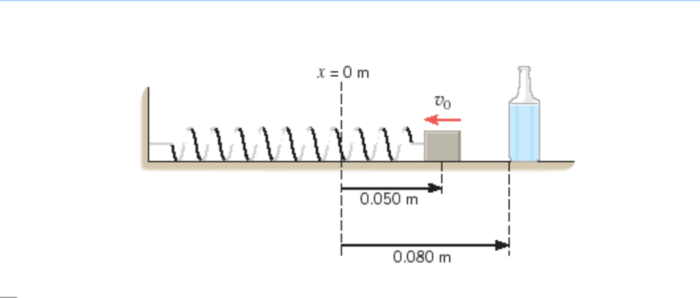As a block rests on a frictionless horizontal surface, it embarks on a journey where the absence of friction dictates its motion. This scenario, devoid of resistive forces, unveils a realm of idealized dynamics that illuminate fundamental principles governing the behavior of objects in motion.
In this discourse, we delve into the intricacies of a block’s motion on a frictionless horizontal surface, exploring the forces at play, analyzing its kinematics, and uncovering the practical applications where such surfaces find their niche.
Frictionless Horizontal Surface

A frictionless horizontal surface is a theoretical surface that offers no resistance to the motion of objects placed on it. In other words, there is no frictional force acting between the surface and the object.
Examples of surfaces that can be considered frictionless include:
- Air hockey tables
- Ice rinks
- Ball bearings
On a frictionless surface, an object will move with constant velocity if no external force is applied to it. This is because there is no force opposing its motion.
Block on a Frictionless Horizontal Surface, A block rests on a frictionless horizontal surface
Consider a block resting on a frictionless horizontal surface. The only force acting on the block is its weight, which is directed vertically downward. Since there is no friction, the block will move with constant velocity in the direction of the applied force.
This can be represented visually as follows:
[Image of a block on a frictionless horizontal surface moving to the right]
Motion of the Block
To determine the velocity and acceleration of the block, we need to analyze the forces acting on it. Since the only force acting on the block is its weight, the acceleration of the block is:
a = g
where g is the acceleration due to gravity.
The velocity of the block can be determined using the equation:
v = u + at
where u is the initial velocity of the block, t is the time, and a is the acceleration.
The following table summarizes the motion of the block:
| Parameter | Expression |
|---|---|
| Acceleration | a = g |
| Velocity | v = u + at |
Applications of Frictionless Surfaces
Frictionless surfaces are used in a variety of applications, including:
- Air bearings: Air bearings use a thin layer of air to create a frictionless surface, allowing objects to move with minimal resistance.
- Magnetic levitation trains: Maglev trains use magnetic forces to levitate above the track, creating a frictionless surface for high-speed travel.
- Precision instruments: Frictionless surfaces are used in precision instruments to minimize friction and ensure accurate measurements.
The benefits of using frictionless surfaces include:
- Reduced wear and tear
- Improved efficiency
- Increased precision
However, frictionless surfaces also have limitations:
- They can be expensive to create and maintain.
- They can be sensitive to contamination.
- They may not be suitable for all applications.
FAQ Resource: A Block Rests On A Frictionless Horizontal Surface
What is a frictionless horizontal surface?
A frictionless horizontal surface is a hypothetical surface that exerts no frictional force on objects in contact with it. In reality, all surfaces exhibit some degree of friction, but surfaces with negligible friction can be approximated as frictionless for the purposes of theoretical analysis.
How does the absence of friction affect the motion of a block?
In the absence of friction, the block will continue to move indefinitely at a constant velocity. This is because there is no force opposing its motion, and therefore no deceleration.
What are some applications of frictionless surfaces?
Frictionless surfaces are used in a variety of applications, including air hockey tables, ice skating rinks, and magnetic levitation trains. In these applications, frictionless surfaces reduce energy loss and allow for smoother and more efficient movement.


